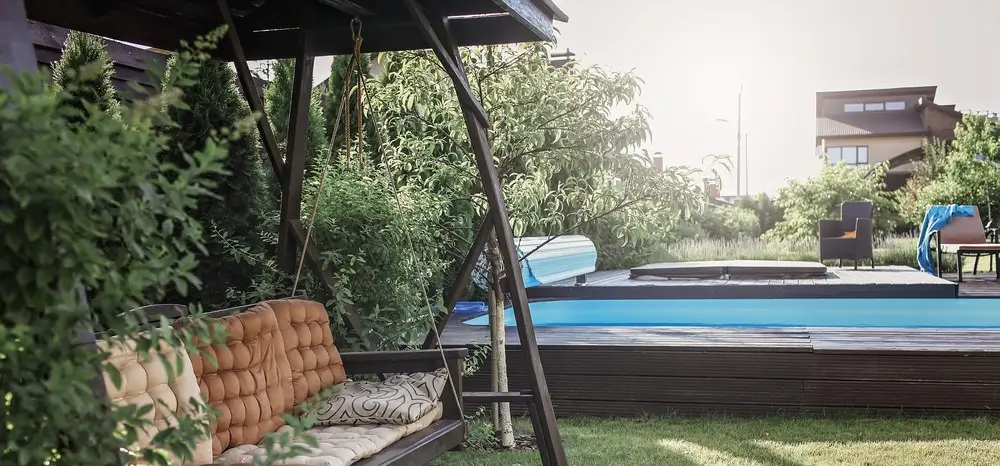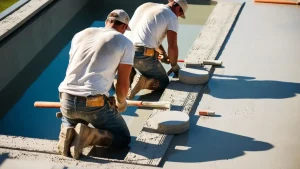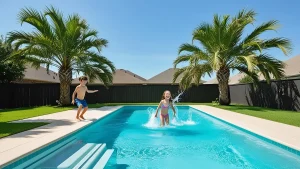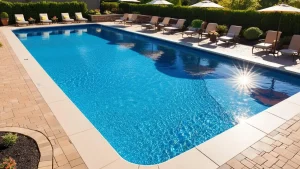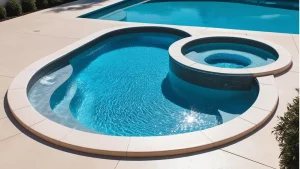Do you want a pool but feel restricted by your sloped yard? Do not let that deter you! A semi-inground swimming pool is exactly the hybrid of both above-ground and in-ground swimming pools. Imagine your pool is buried in the ground. Rising to the top on the other side. This creates a natural transition and enhances the landscape.
Types of Slope Yard Pool
There are many types of pools for sloped yards.
- Fibreglass Pools: Fiberglass Pools are simply fast-installed and prefabricated beautiful pools that can be called convenient installations.
- Vinyl Pools: Vinyl pools tend to be cheap and readily customized. They offer excellent design flexibility.
- Concrete Pools: Concrete pools are the most highly customizable and durable. This type of pool is an excellent long-term investment, but it costs a bit more.
Why choose a Semi Above-Ground Pool in a sloped yard?
Why level the entire yard when you could work with the slope to create something truly unique? Semi above-ground pools on sloped yards can provide the following:
- Cost-Efficiency: It is much more cost-effective to partially excavate your yard than to level the entire area in order for you to install an inground pool.
- Aesthetic appeal: Installed on a slope, your pool will blend harmoniously into the landscape.
- Maximize space: Use every last square inch of your yard to create a verdant oasis with some creative space utilization that would transform into something otherwise unusable.
Plan for a Semi Above-Ground Swimming Pool: Let’s make your dream a reality.
There are a few things you should consider before diving in to make sure your semi above-ground pool is all that you imagined.
Consideration of slope:
How steep is your slope? Slight slopes are easier to maintain than steep slides, and the work involved will depend on how steep your yard is.
Pool Size and Shape:
The right size and shape can make a huge difference. The rectangular pool is ideal for small spaces, while the circular and oval pools are best for difficult layouts.
Budgeting:
Take into account all elements. Therefore, it covers items such as pool and retaining wall construction as well as the decking. Planning well in advance could save one from unpleasant surprises in the future.
Prepare the Site and Assess it: Laying Groundwork.
Before moving forward, a professional assessment is essential. Here’s why:
- Land Survey: A comprehensive survey will indicate all possible problems, such as soil instability or drainage issues.
- Soil Stability and Drainage: These should be important to ensuring the stability of soil and drainage, preventing erosion and potential pool damage.
- Site clearing: Clear the area to prepare for excavation.
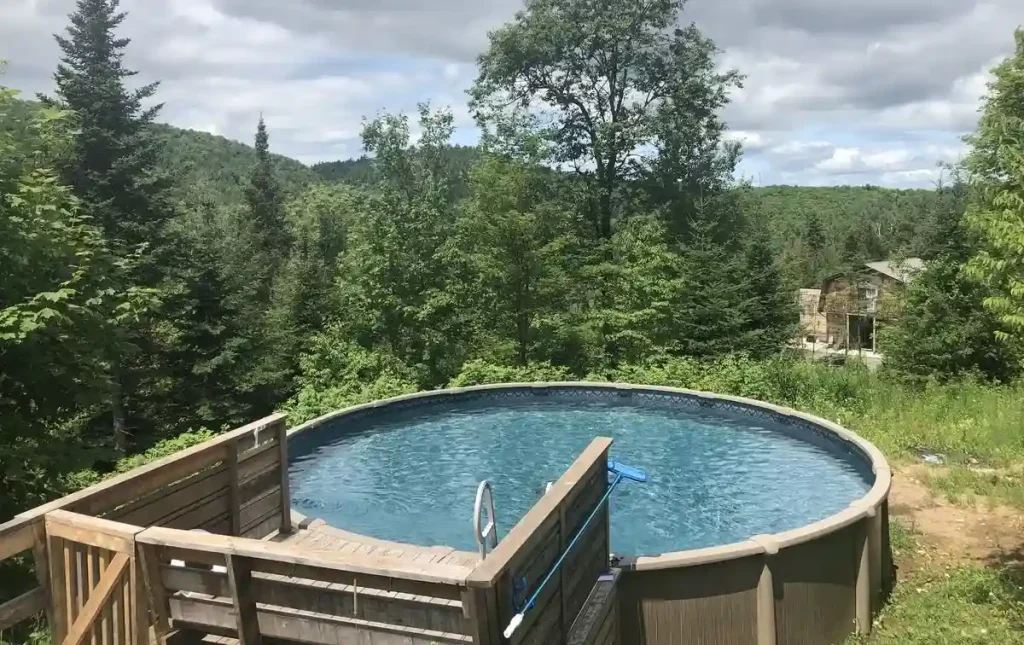
Designing Your Pool Layout – Creating a Perfect Space
Here’s where creativity and functionality meet! If you create a sloped yard pool, consider incorporating it as the centre of your outside space.
Incorporating Retaining Walls:
In addition to the practical answer, here are good examples of possible uses that retaining walls can give. They can also be used as stylish elements that serve as planters, seating, or other decorative features.
Blending with the Natural Slope:
Blending With The Natural Slope – Instead of fighting with the slope, try to work with it. Your yard can be transformed into a multi-level oasis with cascading designs or terraced landscaping.
Decking and Landscaping:
Decking elevated on one side provides both access and a relaxing space, while greenery, lighting and pathways around the deck complete the look.
Excavation and Groundwork: The Foundation of Your Pool
For your pool to be safe and durable, you must perform the excavation process correctly.
Preparing Base: The base must be stable, firm and well-compacted. Add a layer
Partial Excavation: Partial Excavation Depending on your slope, you may need to excavate primarily on one side, while minimal excavation is required for the other. This method is cost-effective and provides a stable foundation for your swimming pool.
Managing Elevation: Manage Elevation – Use the soil excavated to level other areas of your lawn or reinforce the base retaining walls. This method is eco-friendly and reduces waste. It also improves your landscape’s overall structure.
Pool Installation Process: Bringing Your Dream Pool to Life
Installation is a thrilling phase where your plans come together. This is a step-by-step breakdown.
- Place the Pool Frame or Shell: Place the pool frame on the base you have prepared, and make sure it is securely supported.
- Install structural supports: Especially on the elevated side of the pool, structural reinforcements will be crucial to the stability.
- Add Electrical and Plumbing Components: Proper electrical and plumbing components, such as pumps and lights, are necessary for safety and functionality.
- Test for Stability: Before completing the installation, fill the pool to check the stability of the foundation.
- Reinforcement: For the side that is exposed, it may be necessary for the pool wall to be reinforced with steel or concrete.
Choose the right materials and construction for your yard.
Poor materials for constructing swimming pools will not only prove to be long-term deterrents to their beauty and longevity. Still, they will also prove just as much a nuisance as unattractiveness.
- Fiberglass Pools: They are lightweight, prefabricated, and easy to install. As algae-resistant, fibreglass pools also don’t require high maintenance.
- Vinyl pools: Vinyl is one option for its customizable qualities and affordability; however, the liner replacement is necessary every 7 to 10 years.
- Concrete Pools: A concrete pool would be a great choice for its durability, customization, and long life, but also its larger investment and longer installation time.
Pro Tip: Weather-resistant materials like concrete or asphalt can be used in yards with slopes where soil movement is a problem.
Protecting your family and yard: Safety considerations.
While installing a swimming pool in a sloping yard, safety should always be a priority. With the right precautions, you can eliminate other risks, such as erosion or irregular surfaces.
- Fences and barriers: Install a fence for children and pets to keep out of the pool.
- Good Drainage: Prevention from erosion. French drains and slope-specific drainage can help reduce this risk.
- Slip Resistant Surfaces: Make the pool deck slips resistant to rainy conditions so that no accidents happen while stepping into the pool.
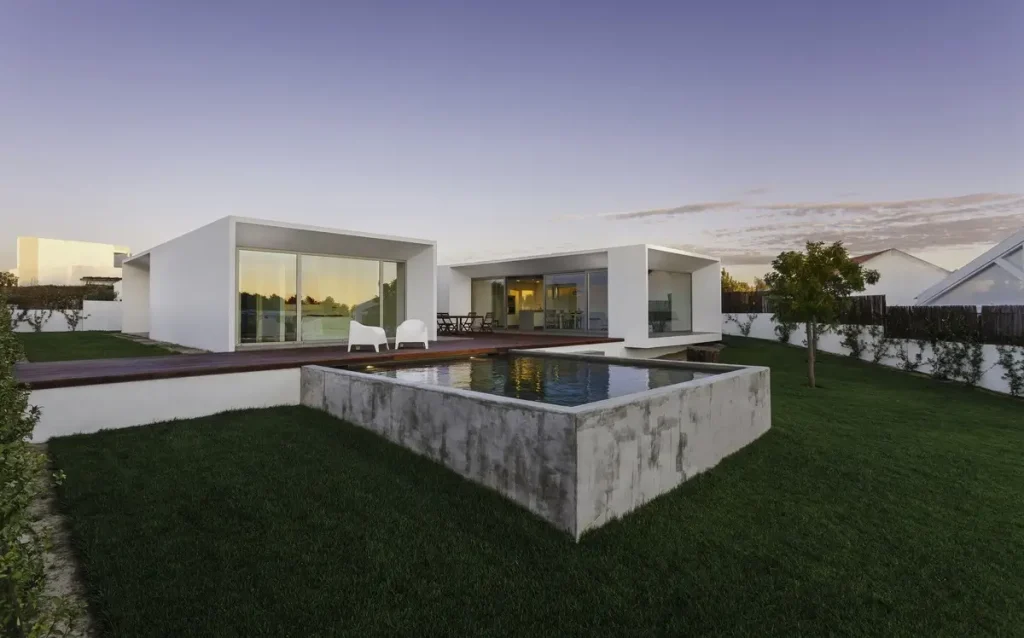
Surrounding the Pool Landscape: Design Your Oasis
Your semi above-ground pool will look beautiful and be more functional with the right landscaping.
Plants and Greenery:
Select low-maintenance yet non-messy plants: those that do not drop any loose leaves or roots into water. Examples include succulents, potted plants, and possibly ornamental grasses.
Lighting Solutions:
Install solar-powered LED lights or any other kind of lighting in your pool area, along the pathways, and between steps for added illumination. A lighting system, besides being made to ensure safety, adds elegance and stands in for such sightings during swimming at night.
Seating and Recreation Areas:
Create inviting, cosy spaces with seating like lounge chairs, benches, or a firepit. Multi-level seating is perfect for sloping yards. It maximizes space and adds charm.
Taking care of Semi Above-Ground pools
Keeping well-maintained all those years for a good swimming pool has certainly paid off.
- Maintaining Pool:
Use an automatic pool cleaner or vacuum to clean up the pool, keeping clear water. Check regularly the pH level and the chlorine level for proper water safety. - Prevent algae growth and debris accumulation:
Cover the pool from possible debris roots. Brush cleaning on walls may also hinder algae growth. - Winterizing Your Pool:
If you live in a region with severe north winters, you would have to winterize the pool, drain water, cut off the plumbing and cover it securely.
Budgeting and Cost Breakdown: Planning the Future
You can plan and avoid unpleasant surprises by understanding the costs of your semi above-ground pool.
| Cost Category | Estimated Cost Range |
| Initial Installation Costs | |
| Pool structure (depending on material) | $10,000–$50,000 |
| Excavation and retaining walls | $5,000–$15,000 |
| Long-Term Maintenance Costs | |
| Annual cleaning and water treatment | $500–$1,500 |
| Repairs or liner replacements | Varies by pool type |
Save money with these tips:
- Choose energy-efficient equipment for your pool to reduce energy costs.
- Reduce transportation costs by using local materials in landscaping.
Case Studies and Real-Life Examples: Inspiration for Your Pool
Success stories in real life can be used to inspire and guide your project. Here are some examples:
- Case Study 1:
An owner transformed a steep backyard area into a luxurious swimming pool by adding terraced landscaping as well as a wraparound deck. - Case Study 2:
A couple created a pool area that is kid-friendly by using minimal digging and incorporating retaining wall seating.
Lessons learned: Hiring professionals to help you and using materials of high quality are the keys to avoiding costly errors.
Conclusion: A Dream Pool Awaits
Installing a semi above-ground pool in a sloped yard can be more than a practical solution. It’s also an opportunity to improve the beauty and functionality of your property. You can design a pool to be both beautiful and functional by planning carefully and working with the slope.
How long does installation take?
Installation can take between 2 and 6 weeks, depending on your yard’s complexity and the type of pool you have.
What is the best material for sloped yards and gardens?
Both fibreglass and concrete pools can be adapted to uneven terrain and are durable.
Can I build a semi above-ground pool myself?
Although it may seem like a small project, a professional installation is always recommended.
What are the typical yearly expenditure amounts associated with running the pool?
In fashion, every year, fees for pool preservation can range from approximately $500 to $1,500, depending on the size of the pool and the unique services required.
Is installing my equipment going to need a permit?
Most regions do require permits for the installation of pools. Check your local regulations prior to starting any project.

